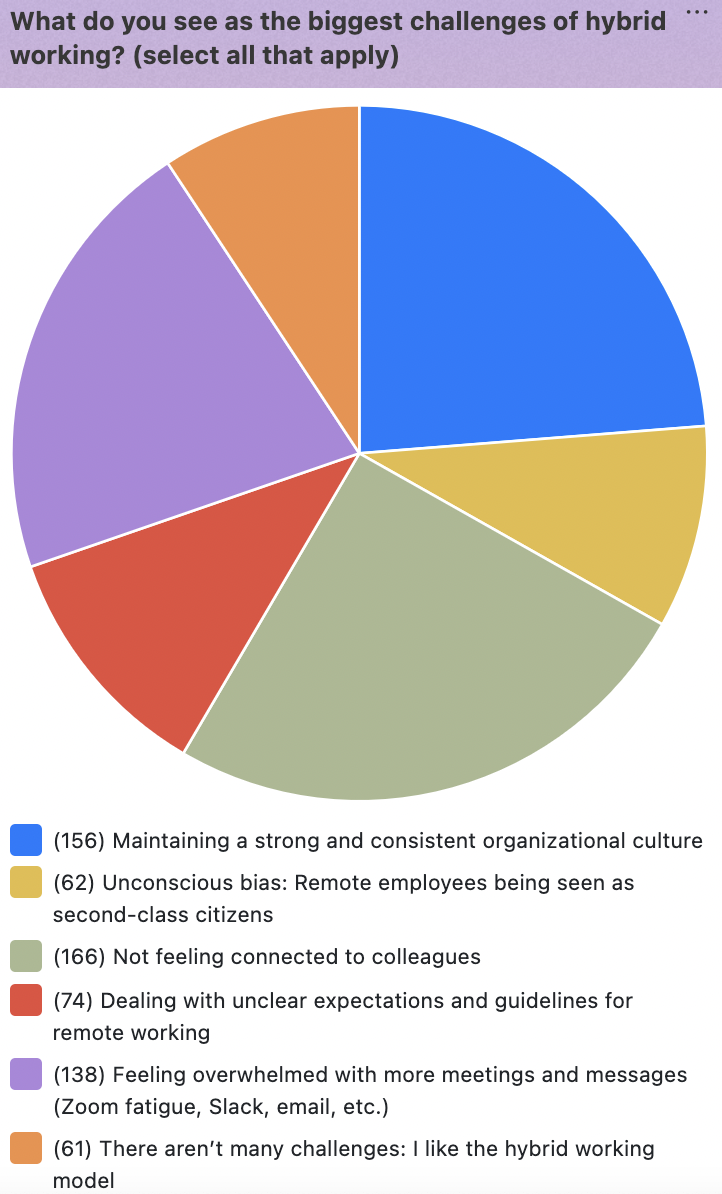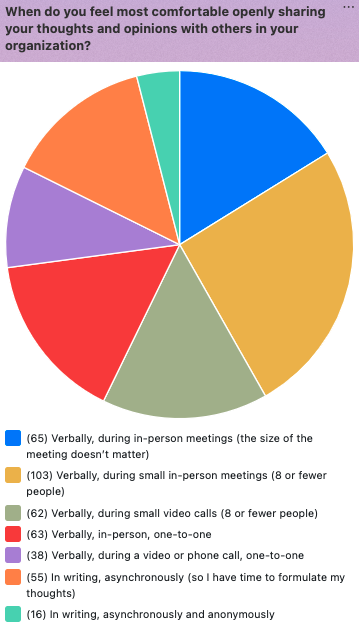
How to build a strong organizational culture in the hybrid workplace
The hybrid work model—combining on-site and remote work—is becoming the new normal for organizations across the globe. But there’s no denying that this model is more challenging compared to a fully virtual or in-office model. Many leaders are struggling to maintain a cohesive organizational culture while some employees choose to work remotely and others meet live at the office.
An organization’s culture tends to emerge over time, especially in periods of rapid change. In light of the rapid change brought about by COVID-19, it’s not surprising that maintaining a strong culture was seen as a top challenge of hybrid work, according to a survey we at Howspace conducted on the topic. The survey sample was 303 team leaders, consultants, and employees across a range of industries and organization types and sizes in 31 countries.

How can organizations overcome this common challenge?
Co-create your hybrid work environment
When it comes to planning new hybrid work arrangements, make sure they accentuate your company’s values and support its culture. How? Work together with everyone in the company to create a new work model that’s engaging, fair, inspiring, and meaningful.
Culture is foundational to your entire organization’s success, which means that thoughts and ideas from the entire organization are needed to understand how the culture can and should change.
Rather than just running one survey to collect employee feedback, nurture constant feedback to maintain a strong team culture. Engage your employees through continual dialogue to help them move from awareness of the change, through understanding it, to embracing it.
Boost feelings of psychological safety among your hybrid workforce
How can you get regular, honest feedback from everyone in your organization—even the more reserved employees? Not every person feels comfortable sharing their thoughts out loud or in meetings. In fact, people’s preferences for sharing their opinions with others varies quite a bit, according to our survey results:

A digital collaboration environment enables you to create a transparent dialogue between a limitless amount of people, no matter where they are. This makes it easy for everyone—even the more reserved participants—to take part in discussions and voice opinions at any point.
By increasing feelings of psychological safety, trust, and of belonging to something important, you’ll strengthen the best parts of your company culture.
One way to promote open expression is by allowing employees to share their opinions anonymously. When employees feel comfortable opening up in a safe space, you’ll get more honest feedback to work with. You can pose a question in a digital collaboration platform, and employees can write their comments and see others’ anonymous comments. You can then create small break-out groups for employees to discuss the topics that came up. Even if this exercise won’t lead to solutions or immediate actions, it introduces vulnerability to the team, which promotes meaningful relationships.
Trust is key for a successful hybrid work culture
One of the main challenges with hybrid work surrounds making assumptions about the work of others when employees aren’t sharing the same context—meaning working on the same projects, being in the same meetings, or otherwise working collaboratively. When we don’t see each other every day, it’s easy to make assumptions about other employees.
The solution to this is asking curious questions and avoiding making negative assumptions about others. At Howspace, mutual appreciation and positive assumptions are our guiding principles. We aim to keep our assumptions positive, trusting that everyone is doing their best and making responsible decisions. When decisions are made that you don’t understand, ask with curiosity and without judgement why that decision was made so that you can understand the thought process better.
Shifting mindsets this way helps to build a positive culture around the hybrid work model.
Rethink meetings in the hybrid workplace
Feeling overwhelmed with more meetings and messages was another top challenge with hybrid work, according to our survey results. Zooms and virtual meetings (which are needed from time to time for coordination) are playing too heavy of a role as part of hybrid work. We need to learn new ways of working where not all working hours are sent in back-to-back meetings and the ‘real work’ is done on weekends and evenings.
As Keith Ferrazzi, chairman and founder of Ferrazzi Greenlight said, “What most companies did this past year is export every meeting of 15 people into a virtual room of 15 tiles and follow the same old rules. There’s not enough stopping to think: Do we even need a meeting to solve this problem?”

©Seth Phillips/Dude With Sign
Plus, 74% of team members in traditional meetings are conflict avoidant, according to Ferrazzi Greenlight research. “They do not speak up with the courage and candor that is necessary to mitigate risk in projects or spark the bold thinking that ignites innovation,” says Ferrazi.
Maintaining a strong organizational culture in the hybrid model calls for new ways of collaborating that allow for a balance of focused work and opportunities to discuss ideas and opinions together.
Finding new ways of working can be done by adapting a facilitator’s mindset—understanding how human relationships work and designing the work to best suit these habits and needs. We can take an exploratory approach and ask ourselves “How can I best accomplish this goal?” rather than automatically booking a meeting, for example.
Consider using meetings as the last resort—rather than the default way—to discuss things together as a group. You can free up your team’s schedule by eliminating some meetings and making other meetings, such as status updates, asynchronous instead.
And when you do get together, pay close attention to how you set up your meetings, workshops, or processes. When everyone understands the purpose of the session ahead of time, participants are more likely to engage in meaningful discussions on the topic. Make sure participants understand the reason why they’re present and what they’re trying to achieve. You can set the context and agenda well beforehand, and ask participants to do some pre-work to tune into the topic.
One survey respondent reflected on connection in the hybrid work environment: “I love meeting in person with my team. But our connection is already created through virtual meetings that we dedicate to strengthen our culture, purpose, and mission and in the way we communicate with each other in team meetings. When we see each other everything is even better but the value is already created—it only gets stronger.”
Want more tips for succeeding with the hybrid work model? Download our Hybrid work model playbook for research-backed insights, tips, and strategies for succeeding with hybrid work.
You might be interested in these as well
View all
Make Your Decision-Making More Inclusive and Effective
Participatory decision-making taps into the collective wisdom of your entire workforce. Here’s how to make more impactful decisions in your organization.

The best change management tools for successful organizational transformation
Embracing change within organizations can be challenging, as people naturally resist it. However, utilizing the right change management software can […]

Top 7 Virtual Organizational Transformation Strategies
When it comes to organizational transformation strategies and how to effectively lead change in a virtual environment, my pro tip […]